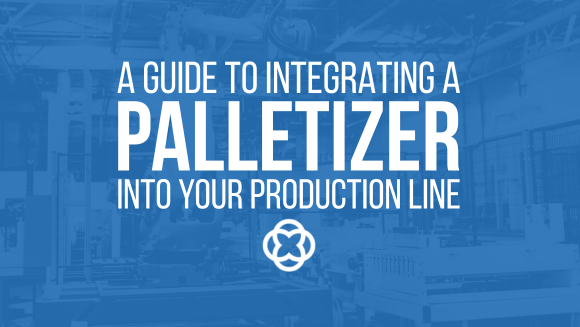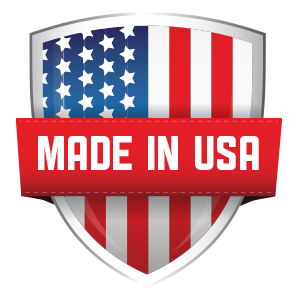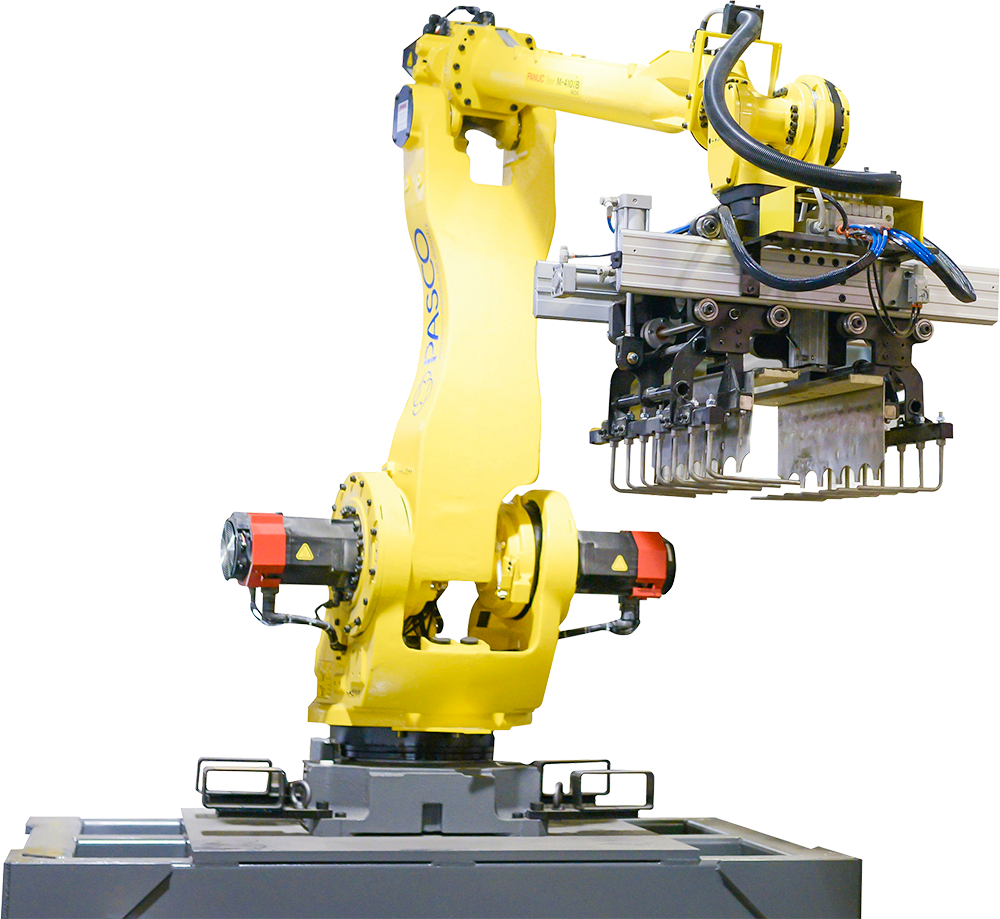Palletizers automate the last step of production, stacking bags, cases, drums and other packaging types onto pallets. We’ve installed over 2,000 systems since 1976 for facilities running modern automated lines and operations where workers still hand-load products.
This guide explains our integration approach — how we work with you to assess your facility, design systems around your existing equipment, validate before installation and ensure smooth commissioning with minimal downtime.
Our integration process starts with collaboration
Site visit or consultative conversation with your team
Integration begins with understanding your operation. For some projects, that means a site visit where we see your facility firsthand. For others, it’s detailed conversations with your plant managers or operations team. After all, you know your facility better than anyone.
What we need to understand:
- Current throughput rates and where bottlenecks occur
- Product types, weights, dimensions and packaging
- Existing conveyor specifications (height, width, speed)
- Your PLC brand, age and communication capabilities
- Available floor space and ceiling height
- Electrical capacity in the installation area
- Compressed air availability and capacity
- Forklift traffic patterns and pallet staging locations
- Downtime windows or production schedule constraints
This isn’t us showing up with clipboards and a checklist. It’s collaborative. You explain your operation, what’s working, what’s not and what constraints we need to design around. We ask questions, but you provide the answers that shape system design.
Many facilities are running at 60% of designed capacity because manual palletizing can’t keep pace with upstream output. These conversations quantify that bottleneck and show where automation integration delivers maximum improvement.
System design based on what you tell us
We design around your facility’s reality, not ideal conditions. The information we source from you drives every design decision.
Control system compatibility: We investigate the PLCs used upstream in your line, then determine integration approach. Modern PLCs with Ethernet get full data exchange while older PLCs get discrete I/O integration.
Upstream equipment variation: We discuss how products arrive — consistent automated feed, variable timing from manual operations, multiple lines converging. Then we design accumulation buffering that matches your actual flow patterns.
Environmental factors: We talk about dust, temperature, moisture or caustic materials. Then we specify components rated for those conditions, like sealed enclosures for cement dust or explosion-proof designs for chemical environments.
Facility constraints: Together, we identify what can’t be moved, where forklifts travel and what clearances exist in your facility. Then we design around those constraints rather than assuming ideal installation conditions.
You receive specifications based on your project requirements:
- System layout drawings
- Electrical and compressed air requirements
- Foundation specifications where applicable
- PLC integration approach
- Facility preparation timeline
The specifications package and timing varies by project. We work with you to provide the information your team needs when they need it to complete preparation work.
We manufacture critical components in-house
Why manufacturing control matters for your integration
We manufacture robot risers, conveyors, enclosures, cabinets, control panels, pallet dispensers, end-of-arm tooling and other critical components from raw steel in our facility. This manufacturing capability directly impacts your integration timeline and long-term system reliability.
Integration advantages:
- Less waiting on external suppliers for critical components during your project
- Custom conveyor built to integrate with your existing equipment
- End-of-arm tooling designed specifically for your product characteristics
- Faster spare parts availability after installation — we machine replacements instead of ordering from offshore suppliers
Manufacturing control means we’re not adapting standard designs to fit your application. We’re building components specifically for your products and environment based on what you’ve told us about your operation.
Pre-installation validation catches issues before we arrive
Complete system testing in our facility
We assemble and test your entire system before it ships. This validation phase identifies and resolves potential issues in our controlled environment, significantly reducing on-site installation time and your production disruption.
What we validate:
- Robot motion paths clear all mechanical obstacles
- Tooling design reliably picks and places loads
- Communication between robot controller and control panel operates correctly
- All safety circuits function — emergency stops, light curtains, guard interlocks
- Pallet patterns stack products correctly for your configurations
- Cycle times meet target throughput at simulated production speeds
Problems get resolved in our shop, not on your production floor during installation. Pre-installation validation reduces on-site time by up to 50% compared to systems that arrive untested. Less time at your facility means less production disruption and faster return to normal operation.
Installation approach minimizes your downtime
Preparation at your facility
Your maintenance team completes preparation work based on specifications we’ve provided.
Typical requirements:
- Electrical service to robot location
- Compressed air supply if using vacuum grippers
- Foundation work for certain system configurations
- Any modifications to existing conveyors for interface connection
Most facilities handle this with existing maintenance staff or local contractors. We provide the specifications your team needs to complete preparation work.
On-site installation phases
Most operations complete installation within two weeks. Proper pre-installation validation significantly reduces on-site time.
Phase 1: Physical installation
- Set robot base, conveyors and other system components
- Align and connect to your existing conveyor system
- Complete all electrical connections
- Connect compressed air lines
Phase 2: Controls integration and commissioning
We validate during commissioning:
- Robot controller communicates properly with your facility PLC
- Product flow triggers correct start/stop sequences
- Fault propagation works both directions (palletizer stops, upstream responds; upstream faults, palletizer enters safe state)
- Emergency stops function correctly
- System runs at target speed with your actual products
This testing prevents product accumulation issues, unexpected stoppages, and safety gaps.
Phase 3: Training and production validation
Your operators and maintenance team learn operation and maintenance before we leave:
- Normal operation procedures
- Pallet loading and changing
- Error recovery methods
- Pattern selection for different products
- Basic troubleshooting
- Routine maintenance tasks
We run production validation to ensure your actual products hit target speeds before sign-off. The system doesn’t transfer to you until it performs as specified.
Working with your production schedule
Single-shift operations: You tell us when you can afford downtime. We schedule installation during planned maintenance windows, long weekends, or lower-demand periods.
Continuous operations: You coordinate with your production planning for reduced capacity period. Some facilities shift production to alternate lines during our installation. Others schedule during seasonal low periods.
Minimal downtime requirement: We work with you to develop an installation approach that minimizes production impact based on your operational constraints.
Common integration scenarios we address
Older control systems
Not every facility runs modern PLCs with Ethernet capability. Many operations rely on control systems installed in the 1990s or early 2000s that still run production effectively. We integrate with legacy controls without forcing you to replace equipment that works.
Tight facility layouts
Retrofit installations often work within constrained spaces where production lines already occupy most available floor area. We design systems that fit your existing layout rather than requiring you to reconfigure your entire facility.
Variable product flow
Upstream equipment doesn’t always deliver products at consistent intervals. Manual operations, variable fill times, and converging production lines all create uneven flow. We address these variations so the robotic system handles your actual production conditions.
End-of-arm tooling requirements
Different products require different handling approaches. We manufacture custom tooling based on your specific products and packaging to ensure reliable picking and placing.
Harsh operating environments
You tell us about dust, temperature extremes, moisture, or caustic materials in your operation. We specify components rated for those conditions.
Cement plants and heavy dust environments:
- IP65+ rated sealed enclosures prevent dust ingress
- Protected electrical components
- Dust-resistant robot seals
Ice plants and washdown facilities:
- Sealed components resist moisture in wet production environments
- Washdown-rated enclosures withstand frequent cleaning cycles
- Corrosion-resistant materials for high-humidity operations
Chemical facilities:
- Explosion-proof designs where required
- Class II Division 1 & 2 certifications for dust environments
- Corrosion-resistant materials
Environment changes component specifications, not whether integration works. We’ve installed systems in ice facilities to cement facilities with heavy silica dust.
What you receive after installation
Complete documentation transfer
You receive system information needed to operate and maintain equipment:
Technical documentation:
- Files showing complete system layout
- Electrical manual
- Mechanical manual
Operational documentation:
- Maintenance schedules
- Spare parts lists with part numbers
Training ensures your team’s readiness
Comprehensive training reduces your dependence on external support and minimizes downtime when issues occur.
Operator training covers:
- Normal operation procedures and start-up sequences
- Pallet loading and changing procedures
- Error recovery methods for common faults
- Pattern selection and changeover for different products
- Basic troubleshooting before calling for support
- Routine maintenance procedures and schedules
Operations receiving thorough training report 60% fewer service calls during the first year. This self-sufficiency reduces your ongoing support costs while maximizing system uptime.
Ongoing support after commissioning
Service options
Preventive maintenance: Scheduled service visits include component inspections, software updates, greasing and mechanical checks. Preventive approach identifies wear before it causes unexpected downtime.
Remote diagnostics: Track performance metrics, fault history and component condition. We can sometimes identify and resolve issues remotely without site visits, significantly reducing your downtime and ensuring our techs arrive prepared.
As-needed service:
- Phone support during troubleshooting
- Emergency site visits when needed
- Spare parts with next-day shipping for critical components
Service credentials
FANUC Authorized Servicing Integrator: Master Certified Technicians diagnose and repair FANUC robots. This is the highest-level certification FANUC offers — we can handle any FANUC robot issue quickly and correctly, whether warranty work or not.
Yaskawa Authorized Partner: Trained technicians service Yaskawa platforms with factory-backed support and parts access.
We also service ABB and Kawasaki robots deployed in our systems.
Ready to start the conversation about integration?
Integration starts with understanding your current operation, existing equipment and facility constraints. We work collaboratively with your plant managers and operations team through site visits or detailed conversations to design systems that fit your production reality.
Initial discussions determine:
- System configuration that fits your throughput requirements and operational preferences
- Integration approach based on your existing controls
- Timeline for facility preparation and installation
- What changes at your facility before we arrive
Contact PASCO
We’ve deployed over 2,000 systems since 1976 and manufacture the lion’s share of critical system components in-house. As a FANUC Authorized Servicing Integrator and Yaskawa Authorized Partner, we provide factory-backed support for the robots in your system. When you call, someone answers within three rings. No phone trees, no waiting for callbacks.



